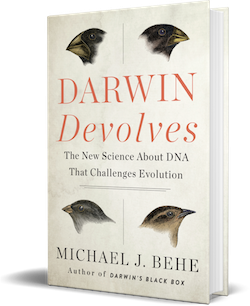 Evolution
Evolution
 Intelligent Design
Intelligent Design
Michael Behe’s Darwin Devolves Topples Foundational Claim of Evolutionary Theory


Editor’s note: Darwin Devolves is currently being sold by preorder. The limited-time offer includes a new 41-part online course with Michael Behe, a bonus chapter, and an exclusive, national conference call. You can and should preorder here right now.
I saw at the website Peaceful Science that biologist Nathan Lents, author of Human Errors: A Panorama of Our Glitches, from Pointless Bones to Broken Genes, says that he has been asked to review Mike Behe’s new book, Darwin Devolves: The New Science About DNA That Challenges Evolution (DD). Professor Lents notes:
I’ve been commissioned to review Behe’s new book, out next year, so I am reading it now. I’m about 70 pages in and so far, all I’ve seen is, “Gee, this stuff is complicated!”
Lents can rest assured: There is far more to the book than that. Behe dismantles the fundamental claim of evolutionary theory that mutations and natural selection naturally drive life toward greater complexity as new information is constantly generated. In stark contrast to this belief, Behe demonstrates the opposite. He summarizes the thesis of his book by stating
With surpassing irony it turns out that…Darwinian evolution proceeds mainly by damaging or breaking genes, which, counter-intuitively, sometimes helps survival. In other words, the mechanism is powerfully de-volutionary. It promotes the rapid loss of genetic information. Laboratory experiments, field research, and theoretical studies all forcefully indicate that, as a result, random mutation and natural selection make evolution self-limiting. That is, the very same factors that promote diversity at the simplest levels of biology actively prevent it at more complex ones. Darwin’s mechanism works chiefly by squandering genetic information for short-term gain.
Several Red Flags
Behe begins by describing several red flags that demonstrate how evolutionary claims often represent a pretense of knowledge without real substance. For instance, in statements such as
…every cell has evolved mechanisms that identify and eliminate misfolded and unassembled proteins.
one could simply remove the word “evolved” and no meaning would be lost. In other words, most evolutionary accounts include no significant details, so they provide no actual knowledge.
Behe then describes several wonders of nature, such as insects with gears, bacteria that construct internal magnets out of toxic materials, and special cells in eyes that act as fiber optic cables tuned to specific wavelengths of light. I found this section particularly captivating. It also provided a stark contrast between the innovations seen in nature and natural selection’s observed limitations.
The Core Argument
The following section lays out the core argument of the book which centers on the empirical data gleaned from the most thorough studies of evolution on the molecular level. Such research has only become possible in the last twenty years since new technology has enabled sequencing of DNA on large numbers of organisms. For the first time, evolutionary claims can be properly tested, and Behe presents the most rigorous analysis to date based on hard data. He describes research on numerous organisms including the following iconic examples:
- Darwin’s finches: Approximately a dozen species of finches on the Galápagos island descended from a single species over a period of two million years.
- Cichlid fishes: About 500 species of cichlid fishes in Lake Victoria evolved from a single species over a period of 15,000 years. Similar numbers of species evolved from single species in Lake Malawi over a few million years and in Lake Tanganyika over 10 million years.
- E. coli: Approximately 60,000 generations of E. coli were studied by Richard Lenski’s research group. They periodically froze samples, so the changes in DNA could be mapped throughout the populations’ histories.
All studies demonstrated the same basic results. First, the vast majority of adaptive mutations degrade or outright disable genes. For instance, the gene most strongly associated with the difference in blunt-beak verses pointed-beak finches is called ALX1. The only variation in it throughout all finch species is two mutations that both impair function. Similarly, the E. coli strains that best adapt to strong selective pressures primarily disable genes that are not immediately needed for survival. Behe labels this result the First Rule of Adaptive Evolution:
Break or blunt any gene whose loss would increase the number of offspring.
First Rule of Adaptive Evolution
This rule is easy to understand. Random mutations can far more easily break a gene than enable some new function, so solutions to challenges that involve breaking a gene will predominate. An analogy Behe uses is a person whose house is filling up with water due to a leaky pipe. The available options are to break a hole in the wall to allow the water to escape or wait for a pump to be delivered that happens to be on a ten-year backorder. The obvious solution would be to break a hole in the wall.
 Second, mutations that modify a function are far fewer and represent trivial changes. For instance, the most widely publicized result from Lenski’s lab was the appearance of strains of E. coli that were able to eat citrate. However, the bacteria already have this ability. It is normally switched off in the presence of oxygen. The fortunate bacteria obtained an alteration that allowed them to access citrate in all conditions. The third observation is that mutations which initiate new functions or modify existing ones still usually lead to the loss of significant quantities of genetic information. In the previous example, the citrate-eating bacteria developed additional mutations which resulted in the loss of function in several other genes. In the end, the strains fine-tuned their metabolism to the new environment, but at the expense of losing the ability to survive in the original one. As another example, the bacteria that caused the Black Death in the 14th century evolved from a free-living benign species that lives in the soil. However, it acquired new genetic information from another bacteria which allowed it to live in a human host. In the new environment it quickly lost numerous genes which confined it to a parasitic lifestyle.
Second, mutations that modify a function are far fewer and represent trivial changes. For instance, the most widely publicized result from Lenski’s lab was the appearance of strains of E. coli that were able to eat citrate. However, the bacteria already have this ability. It is normally switched off in the presence of oxygen. The fortunate bacteria obtained an alteration that allowed them to access citrate in all conditions. The third observation is that mutations which initiate new functions or modify existing ones still usually lead to the loss of significant quantities of genetic information. In the previous example, the citrate-eating bacteria developed additional mutations which resulted in the loss of function in several other genes. In the end, the strains fine-tuned their metabolism to the new environment, but at the expense of losing the ability to survive in the original one. As another example, the bacteria that caused the Black Death in the 14th century evolved from a free-living benign species that lives in the soil. However, it acquired new genetic information from another bacteria which allowed it to live in a human host. In the new environment it quickly lost numerous genes which confined it to a parasitic lifestyle.
A relatively small number of beneficial mutations do occur that do not incur negative costs, but they always represent miniscule changes. For instance, certain species of cichlid fish obtained a mutation in a rhodopsin protein which allowed for greater sensitivity to light at greater, versus lesser, water depths. But the new protein only differed from the original by a single amino acid. This single alteration represents the most impressive feat of evolution in one of biologists’ most prized case studies over a period of time comparable to that in which the largest transformations took place in the fossil record. Contrast this change with the hundreds, if not thousands, of coordinated mutations that are required to construct the fiber optic eye cells mentioned above.
The Big Picture
The big picture conclusions of all studies is that evolutionary processes are only capable of driving changes at the level of species and genera, but not at the level of families or higher. Stated differently, evolution produces a limited number of changes and then no further significant change is possible. For instance, the adaptations seen in the cichlid fish in Lake Victoria over 15,000 years closely match those seen in the cichlid fish in the other lakes after several million years. The same limited number of changes repeated themselves over and over. In addition, all modifications represent minor alterations of the same cichlid body plan.
The evidence commonly cited to argue for evolution’s ability to drive large-scale transformations is almost always circular. Biologists regularly identify similarities and differences between two groups and then assume those differences are the result of natural selection, mutations, and related processes. However, this conclusion is not based on any actual hard evidence. It is simply assumed. As Behe demonstrates, all empirical data point to the conclusion that evolution is only capable of producing minor alterations of existing designs but nothing truly novel. Evolutionists must now to an even greater extent disconnect their grand narratives from empirical data and confine them to the realm of their unrestrained imaginations. Anyone interested in knowing the truth about the design/evolution debate will find Darwin Devolves a must read.
Photo credit: U.S. Air Force.
